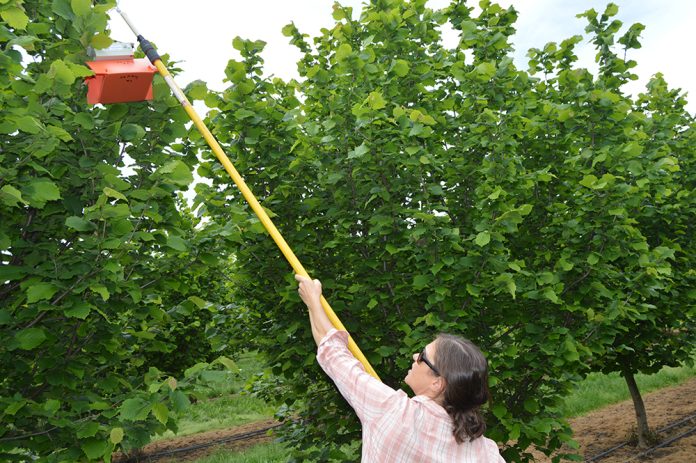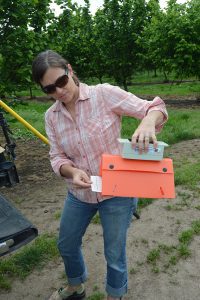
Automated insect traps, which for several years have been deployed in mating disruption programs in almonds, apples and other high-value specialty crops, are now available for tree nut growers using conventional insect control programs.
Semios, a precision crop management company with headquarters in Vancouver, British Columbia, has recently begun making the traps available under a contract basis for conventional growers, and a second Vancouver, B.C., company, CropVue, is working with suppliers this year with plans to release an automated trap to growers in 2023.
“We are in pilot programs with several partners for them to test it out and work with it internally and understand how to use it and support it before they introduce it to their customers,” said Terry Arden, CEO of CropVue.
Both companies have multiple years of experience with the traps in mating disruption programs and are confident in the technology’s ability to deliver accurate and timely insect pest counts in both conventional and mating disruption systems.
“There is a lot of manual trapping going on for pests in various crops and fields,” Arden said. “We can see a huge need for a way to automate that and also measure pest pressure in real time. And so, we’ve automated the whole thing. From your laptop, you can log in and look at a Google map of your property and see all the traps and check in on the pest pressure.”
Battery-Operated
The automated traps include a camera powered by batteries and a computer chip that uses cellular signals to transmit images and data that a grower or PCA can access remotely on a phone or laptop on a daily basis.
Batteries on the Semios traps have a two-year life. The company remotely monitors the battery and camera performance and performs maintenance as needed as part of its full-service system, according to Abby Welch, an entomologist who works out of the Fresno office for Semios. Batteries on the CropVue system are charged by an integrated solar panel that keeps traps running for up to five years.
The trapping systems also transmit in-canopy weather data, which can be used to monitor degree-day models.
“We are collecting all of this climate and pest data in the field together as a way to not just inform the grower of their pest activity, but also to create models that pick up on an orchard’s unique variability and pest conditions,” Welch said.
The traps use artificial intelligence (AI) to identify target pests, including the navel orangeworm in California tree nut crops and codling moth in apples.
Arden said CropVue has designed its trap to be easy to use and relatively inexpensive in hopes of overcoming a barrier that he believes has slowed acceptance of precision agriculture.
“This whole precision ag thing, I think, has been slow to catch on primarily because the solutions to date have always been way too expensive for growers. Precision ag needs a lot of data,” he said. “You can’t just put one weather or trap node out there and expect to run your whole farm on it. You need a number of data points if you are going to start trusting the data to inform you on how to do things. And so, the whole cost structure has been prohibitive.”
He said growers can expect to pay a 25% premium over the cost of a manual trap to lease CropVue’s automated system.
Hands-Off System
Betsey Miller, a research assistant at Oregon State University who has been working with the CropVue trap in hazelnuts for three years as part of a mating disruption trial, said the savings in labor the traps provide is significant.
“In terms of utility, they are awesome,” Miller said.
The CropVue automated traps need only be serviced once a month versus once a week for conventional traps, she said, and then only to replace the pheromone lure.
“When we trap in these older orchards, we have to use a telescoping pole to put the traps up and get them down because you need to hang traps in the upper third of a tree to be effective,” Miller said. “So, it is a little cumbersome. And then, depending on how big your operation is, you are hoofing over acres and acres and acres checking on these traps.”
“Camera traps help you save time and money by eliminating manual trap checking to scale your scouting efforts,” Semios’ Welch said. “And Semios provides a hands-off, labor-free install. We install the traps and swap lures and liners for you.”
Also, Miller said, the daily monitoring of insect pressure that the traps provide is giving growers a more accurate assessment of pest pressure given that weekly counts can be skewed by outside influences.
“I have had an image where there are, say, 20 moths on a trap, and then you see a bat head and then in the next image there are two moths,” Miller said. “So, the bat ate most of the moths.
“I don’t think we realized until recently that wild animals could be influencing our trap counts,” she said. “We used to think that maybe the moth was just partially stuck on the sticky card and then flew off. After I saw that image, I realized those could be moths that got stuck and then were plucked off of there.”
Also, knowing insect pressure on a daily basis can help growers stay ahead of outbreaks. “The onset of a pest can be quite sudden,” Arden said. “So, within two or three, days you could have a real problem and not know about it until you check your traps for that week.”

Different Ends
Miller said producers can use the system for different ends. In some cases, where growers know they have hot spots in an orchard, they could place a trap or two traps in the hot spots to determine spray timing. In other cases, growers may want to place multiple traps in a field and use the traps to target sprays.
“They will trap their whole acreage, and if they see just half of the orchard is having a problem, they will just spray that half,” she said.
“You can identify areas of high pest pressure from your phone or computer with automatic daily trap catch reports,” Semios’ Welch said.
How many traps a grower places in their orchard is up to a grower’s discretion, Welch said. But, she said, Semios has determined as few as one trap for every 50 acres can be effective at providing accurate data on navel orangeworm pressure.
Also, both the CropVue and Semios systems offer a notification provision, where a grower can be notified when pest pressure crosses a certain threshold. “At that point, you can take the time to check it out,” Welch said. “So, it gives them more of a streamlined process of planning out their day and having confidence in knowing what their pest population is on a daily basis rather then maybe getting that update on a weekly basis.
“For some people, getting that update on a weekly basis still works,” Welch said, “but some people really enjoy having that daily outlook, as well.
“The last couple of years, we’ve had a lot of acceptance,” she said. “It seems more people trust it and are asking questions about the phenology of the traps and what the numbers mean because now they are getting a daily count.”















